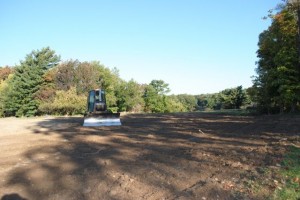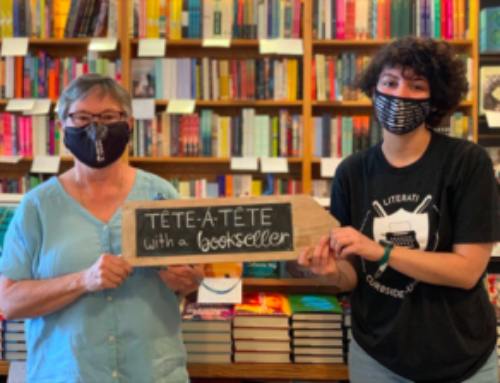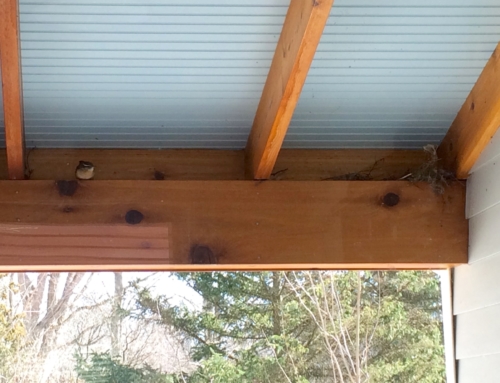I’d been to the woods for my daily hike. Back behind the wheel of the car, my body felt strong and capable—I can climb hills in the sand, quickly. I know these unmapped trails as well as—no, better—than the back of either hand. Flooded with fresh oxygen and touched on all sides by whatever it is that leaves release, I was hardly winded and not sore at all. I was, as they say, in the zone: high on endorphins and good air.
Perhaps because I’d carried a bit of my woods habit of attentiveness back into the car with me, I noticed a brown fox trotting through the unmowed grass, April drab, of an abandoned golf course. She was so close to the road, I could see she carried something small, gray, and songbird sized in her mouth. Thoughts flitted through my mind: aren’t foxes nocturnal? is she a gray or a red? You should stop, Alison. Work can wait awhile. Stop. Get of the car. And go back and look for the fox.
I talk to myself this way sometimes. It helps me settle in, focus, accomplish unquantifiable things.
This fox sighting was unremarkable, except that it happened right in the middle of the day. It would have been rash to let the moment pass, and I did pull off onto the grassy shoulder across from boat warehouses and condos, at least partially to prove to myself that I could, that I do indeed share some small bit of the talent for encountering wild nature that seems inexhaustible in writers like Terry Tempest Williams and Mary Austin.
The sun beat down from the apex of its daily arc. Although it was midday, it was mid-spring and Monday, and so the road to the beach was empty: of cars, runners, bicyclists, lawn crews, of all the in-season bric-a-brac of resort towns.
I waded out into the deep grass. Lake Michigan reached me in sound waves, the surf so high it comprised the sound track a half-mile inland. I thought of the fox, hoped she had not moved on, and that if she hadn’t I wouldn’t startle her. I didn’t have to walk far to reach the top of the sledding hill, which I crested in slow motion, going for a stalker-like deliberation far removed from my usual habit of dashing. I imagine that this (stalker-like deliberation) is the way successful hunters move. Two Canada geese floated on the pond at the base of the hill, and, as if they’d all three gathered at the water together on purpose, the fox nosed around in the weeds nearby. They seemed unaware of each other, the geese and the fox—and of me, but we have all played this game. No doubt they were keenly aware of one another—and of me, just not letting on.
At the very spot where I’ve launched my daughter on her sled, I lowered myself to a crouch very slowly, then wrapped my arms around my knees, also slowly. I didn’t take my eyes from the fox, who did not so much as glance my way. Thank you northwest wind which carried my scent right back to the car. Thank you surf which absorbed my rustles.
The fox trotted directly up the hill towards me, still carrying the limp, gray creature. (Oh for a photo of that to show you!) She was hunting, all purpose and intent. I willed myself to utterly still alertness. My un-hatted hair flew about my head–like leaves, I hoped. Highly polished SUVs passed on the road. The odds were very good I knew the drivers. The glare off the windshields made it impossible to know. Without moving anything but my eyes and the corners of my lips, I glanced over quickly with the abbreviated smile that’s my version of a neighborly nod.
The fox continued to climb the hill towards me. I noted her black-tipped tail and large ears, that she was more brown than red, and bore no black “boots,” a gray fox then. She kept coming on. I kept still. When she was just yards from my lap, our eyes finally met. She didn’t so much as flinch and neither did I. Like flowing water encountering a boulder, she smoothly shifted direction. She turned into the wind, away from the road, trotted a few more yards, and began to poke through the gully of an old golf-cart path, along a crumpled orange snow fence that had long ago stopped serving any purpose. She’d managed to empty her mouth without my notice. Kits were probably heaped warmly in a nearby den. My own daughter was sitting in a classroom a couple of miles away. I wished she was here to see.
When the fox began wandering toward me again I knew she’d determined that the darkish lump in the grass was not a threat, that I had succeeded in settling myself so carefully and quietly that she was carrying on the business of hunting. And so there we were: two mothers, one crouched and awed, the other trotting and intent, out in the wide open under a noonday sky, surrounded on all sides by the human-built world. I desperately wanted to take a photograph.
A couple of times, she had passed so close to me I could almost have reached out and touched her. I had never been that close to a fox. In fact, I’d never been that close to any wild mammal that was simply going about its business. (Neighborhood squirrels, we must admit, are not that wild.) I was struck by the intensity of her focus, the way she tracked odors on the ground the way I’ve watched dogs track odors, starts and stops and starts, eyes slightly hooded. Maybe she wouldn’t notice if I moved a little. I was pretty sure I could do so silently.
I decided to go for a picture. In one single motion I stood and began to lift the camera to my eyes without taking them from the fox—the better to watch the good mother immediately freeze, turn her remarkable eyes and ears toward me, then dash west into the tangled bank that bounded the other side of the overgrown fairway. In seconds, she had evaporated, and I was left standing there feeling impatient, graceless, and stupid; awkward in my human body, the very same one that only an hour or so earlier had felt so right. I suspect she’d known all along that I was a human, but that squatting humans do not move quickly.
Here is what I know for sure: moving through the habitat of wild creatures, on foot and quickly, with my ears and skin tuned in, and my eyes almost always averted, is what I do best, what I have always done best. I am not any kind of hunter, not one who shoots guns or one who shoots cameras.
For the sake of the story and not because it felt like it was the right thing to do, I walked over to the patch of grass where I suspected she’d dropped her mouthful. I found a neat heap of vole corpses—there must have been a dozen, the work of the fox mother’s morning. I did not touch them or step closer. While she had been patiently, deftly gathering fresh meat for her babies in that re-wilding meadow, I’d been dashing through the nearby woods, imagining I could belong there for just a little while, and perhaps I can. Perhaps I do pass through without disrupting, too much. Perhaps it’s okay, once in a while, to stop and watch. Gary Snyder has observed that, if we’re of any use at all to animals, perhaps it’s as entertainment. Maybe I’ll play a role in the stories she tells when she gets back home. In any case, may other clumsy humans stay away long enough for her to notice the lump-turned-Homo sapiens that was me has exited the meadow, and may every one of those dead voles make it to the mouths of her babes.
A little bit of research reveals that the gray fox (Urocyon cinereoargenteus)—and all foxes—are indeed nocturnal—or crepuscular (that wonderful word). The hunter with whom I passed the noon hour was likely out and about because of hungry kits. Gray foxes range across the eastern half of the United States, all across the southern and up the west coast. They’re less widespread but less shy than red foxes and they like to build their dens in banks like the ones at the edge of the fairway we used as a sledding hill—until it became the site of Douglas, Michigan’s newest residential construction project (as pictured)–and they are the only American canids that will climb trees, especially leaning or thickly branched ones like those left in the rough of that old golf course, for now.
I’ll close with a sort of prayer, from the poem “Vixen,” by W. S. Merwin: “let me catch sight of you again going over the wall / and before the garden is extinct and the woods are figures / guttering on a screen let my words find their own / places in the silence after the animals.”










Just wonderful observation and beautifully written .
Thank you!
Leaves release carbon dioxide when they decay.
Thanks for commenting. You might find this National Geographic article interesting: “The Case of the Missing Carbon.” Click on the title to link to the full article.
Allison, thank you for your beautiful narrative.
Jan
Thank you!
Thanks for reminding us that open spaces, like our state and national parks, are also nature preserves which are intended to protect whole ecosystems of indigenous plants and animals. Our forests are more than potential board feet of lumber. Our open spaces are more than potential high-end housing developments and “world class resort destinations” for the top 1%. Thanks for sharing this story.
Thank you for commenting. I’m intrigued by how adaptable animals are . . . making use of the scraps of wildness scattered among our various instances of building things up.
I often wonder about how hard some of us work to make room for all on this vast interconnected web of life, and I fear that as we lose open fallow speces like the old golf course, that we will soon find ourselves alone, with our McMansions and the mosquitos with little more to look at than our next door neighbor’s finely coiffed lawn. Those of us who care so much often need the support of those who can understand our feelings. Thanks for taking the time to look, learn and share. There is such grace in nature.
You’re very welcome. Thank you for spending time with my words and for letting me know your thoughts.